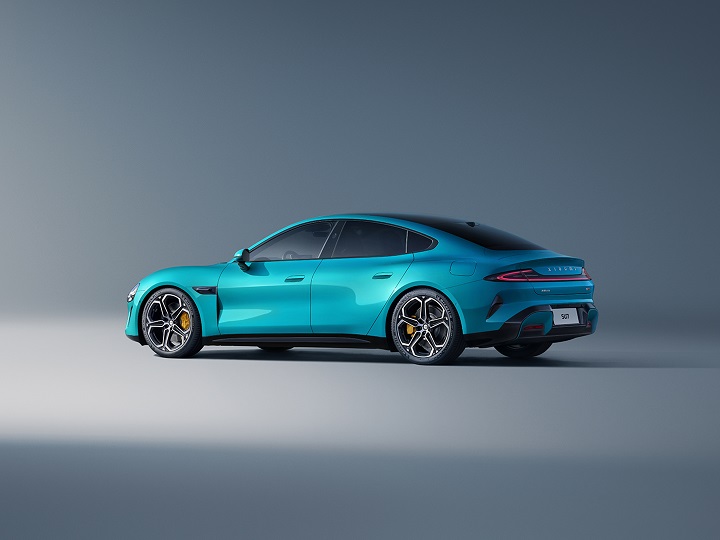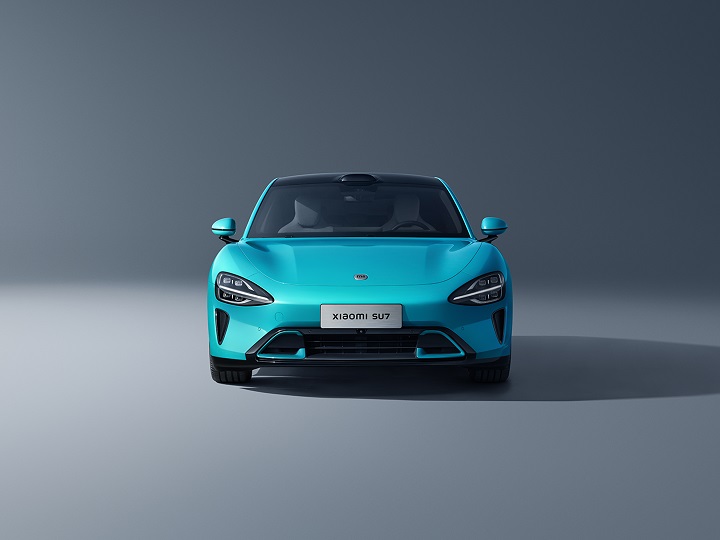During the Xiaomi EV Technology Launch, Xiaomi introduced five key technologies for its electric vehicles: E-Motor, Battery, Xiaomi Die-Casting, Xiaomi Pilot Autonomous Driving, and Smart Cabin. With a focus on developing these foundational core technologies, Xiaomi strives to redefine the automotive industry's technological landscape.
Xiaomi EV is dedicated to a ground-up strategy, commencing with the development of foundational core technologies and thorough independent research in crucial technology sectors. With a pledge to "tenfold investment, conscientiously building a great car," Xiaomi EV has invested over 10 billion CNY in the initial research and development phase. The R&D team comprises over 3,400 engineers and over a thousand technical experts in critical domains, both in China and abroad.
This conference unveiled breakthroughs in the development of Xiaomi EV's five core technologies. In pivotal sectors such as E-Motor, Battery, Xiaomi Die-Casting, Xiaomi Pilot Autonomous Driving, and Smart Cabin, numerous self-developed technologies by Xiaomi EV have achieved global or domestic first-of-its-kind status. This highlights Xiaomi's 13 years of comprehensive technological accumulation since its inception.
Xiaomi EV is dedicated to a ground-up strategy, commencing with the development of foundational core technologies and thorough independent research in crucial technology sectors. With a pledge to "tenfold investment, conscientiously building a great car," Xiaomi EV has invested over 10 billion CNY in the initial research and development phase. The R&D team comprises over 3,400 engineers and over a thousand technical experts in critical domains, both in China and abroad.
This conference unveiled breakthroughs in the development of Xiaomi EV's five core technologies. In pivotal sectors such as E-Motor, Battery, Xiaomi Die-Casting, Xiaomi Pilot Autonomous Driving, and Smart Cabin, numerous self-developed technologies by Xiaomi EV have achieved global or domestic first-of-its-kind status. This highlights Xiaomi's 13 years of comprehensive technological accumulation since its inception.
E-motor
Xiaomi unveiled its E-motors, the HyperEngine V6/V6s and HyperEngine V8s, at the conference. These motors, featuring innovations like Bidirectional Full Oil Cooling, S-shaped oil circuit design, and staggered silicon steel laminations, outperform traditional V8 and V6 powertrains, pushing industry performance to new heights.
The HyperEngine V8s, a global record-holder, boasts a maximum speed of 27,200 rpm, 425kW output, and 635N·m peak torque. Achieving this milestone, it utilizes the industry's first ultra-high-strength silicon steel plate with a tensile strength of 960MPa, surpassing mainstream offerings by over two times.
For efficient cooling, the HyperEngine V8s adopts Bidirectional Full Oil Cooling and an S-shaped oil circuit design. The stator's dual-cycle oil circuit increases heat dissipation by 100%, achieving a cooling effect of up to 20°C. Simultaneously, the rotor section's patented S-shaped oil circuit enhances the heat dissipation area by 50%, reaching a cooling effect of up to 30°C. The stator silicon steel laminations with a "step-like" staggered design further increase the effective heat dissipation area by an additional 7%.
Set for mass production and implementation in 2025 Xiaomi EVs, the HyperEngine V8s signifies Xiaomi's commitment to advancing electric motor technology. Additionally, Xiaomi's self-developed HyperEngine V6/V6s E-motors boast an industry-leading rotational speed of 21,000rpm, surpassing the most powerful mass-produced electric motor globally. The HyperEngine V6 achieves a maximum power of 299PS and a maximum torque of 400N·m, while the HyperEngine V6s super motor achieves 374PS and 500N·m torque.
Battery
Xiaomi has developed CTB Integrated Battery Technology, featuring Inverted Cell Technology, a multifunctional elastic interlayer, and a minimalistic wiring system. This technology achieves the world's highest battery integration efficiency at 77.8%, resulting in a 24.4% overall performance improvement and a 17mm reduction in height. The battery has a maximum capacity of 150 kWh, providing a theoretical CLTC recharge range of over 1200 km.
For long-range travel safety, Xiaomi implements industry-leading safety design standards, including a downward-facing pressure relief valve for swift energy release in extreme situations. A robust 14-layer physical protection system ensures safety with top, side, and bottom layers.
The battery employs a dual-side water cooling solution for efficient heat dissipation, with heat dissipation plates on both sides providing a cooling area of 7.8m², four times the industry average. Aerogel insulation material on the battery cell sides can resist temperatures up to 1000°C.
The Xiaomi EV features a self-developed Battery Management System (BMS) with ASIL-D, the highest functional safety level. This BMS includes three independent thermal runaway monitors and alarms, along with a 24/7 early warning system. Xiaomi's batteries undergo rigorous safety tests, including 1050+ verifications and 96 times the international standard of durability testing duration, ensuring industry-leading reliability.
Xiaomi Die-Casting
Xiaomi introduced its self-developed Xiaomi Die-Casting T9100 cluster and exclusive die-casting alloy, Xiaomi Titans Metal. This unique approach makes Xiaomi the only domestic automaker to research both large die-casting and materials simultaneously.
The T9100 cluster spans 840m², weighs 1050t, and boasts a locking force of 9100t. Xiaomi's innovative quality judgment system completes inspections within 2 seconds, providing efficiency ten times higher than manual inspection. This cluster contributes significantly to Xiaomi EV's success, integrating 72 components in the rear underbody, reducing welded joints by 840, lowering overall car weight by 17%, and cutting production hours by 45%.
In material development, Xiaomi created Xiaomi Titans Metal, a high-strength, high-resilience, heat-treated die-casting material. Using their "Multi-Material Performance Simulation System," Xiaomi selects the optimal alloy formula from 10.16 million possibilities, ensuring an ideal balance of strength, resilience, and stability. Xiaomi's comprehensive approach covers nearly all aspects of the large die-casting industrial chain, focusing on both materials and equipment clusters and finished castings.
Xiaomi Pilot Autonomous Driving
Xiaomi demonstrates its intelligent software technology, bridging the automotive and consumer electronics industries through intelligent ecosystems. In autonomous driving, Xiaomi pioneers three key technologies: Adaptive BEV Technology, Road-Mapping Foundational Model, and Super-Res Occupancy Network Technology.
Adaptive BEV Technology employs scenario-based perception algorithms with a granularity range of 5cm to 20cm, ensuring wider visibility in urban settings, extended vision at high speeds, and precision in parking scenarios.
The Road-Mapping Foundational Model redefines road perception by recognizing real-time road conditions and intelligently adjusting driving trajectories, even in complex intersections, without relying on high-definition maps.
Xiaomi's Super-Res Occupancy Network Technology excels at recognizing irregular obstacles using an innovative vector algorithm for continuous curved surface interpretation, achieving accuracy as low as 0.1m. The one-click noise reduction feature enhances recognition by mitigating the impact of rain and snow.
Xiaomi also independently develops the world's first "End-to-End Sensing and Decision-Making AI Model" for automated parking, enabling real-time observation and dynamic adjustments in challenging scenarios.
On the hardware front, Xiaomi's autonomous driving system boasts top-of-the-line configurations, including two NVIDIA Orin high-performance chips, one LiDAR, eleven high-definition cameras, three millimeter-wave radars, and twelve ultrasonic radars on the Xiaomi SU7 Max model. With full-stack in-house research, Xiaomi aims to position its intelligent autonomous driving system among the industry's elite by 2024.
Smart Cabin
The Xiaomi EV Smart Cabin features a "human-centric" interaction design with a 16.1-inch 3K central console, a 56-inch HUD head-up display, a 7.1-inch rotating dashboard, and two seat-back mounts for tablets. Powered by the Snapdragon 8295 in-car chip, it provides an ultimate interactive experience by linking five different screens with AI computing power of up to 30 TOPS.
The user-friendly Smart Cabin operates like tablets, ensuring quick adaptation without a learning curve. The system launches in a rapid 1.49 seconds, offering seamless cross-device connection with smartphones. The in-car OS integrates mainstream applications, including the entire Xiaomi tablet app ecosystem and over 5000 applications.
Xiaomi SU7 supports over 1000 Xiaomi smart home devices, creating a robust CarIoT ecosystem with automatic discovery, password-free access, and the ability to set up automation scenarios. The car interior features dedicated expansion connections for plug-and-play functionality for various devices.
To cater to user needs, Xiaomi EV fully supports CarPlay, allows mounting of iPads and iPad accessories, and supports applications on the rear extension mount.

Technology x Ecosystem
The Xiaomi SU7 stands out for its cutting-edge technology, offering advanced driving experiences and exceptional performance. Featuring a self-developed HyperEngine E-motor, CTB Integrated Battery Technology, and a body structure made from the Xiaomi Die-Casting T9100 cluster, the SU7 Max achieves a rapid zero-to-hundred acceleration in just 2.78 seconds, earning its place in the "sub-2-second supercar" category and reaching an impressive top speed of 265 km/h.
The Xiaomi SU7 is a versatile performer with the fully self-developed Xiaomi Smart Chassis control algorithm. This algorithm provides Smart Multidimensional Sensing and Global Synchronized Control, ensuring millisecond-level adaptive dynamic chassis control for a stable and almost "bump-free" driving experience in any scenario.
Moreover, the Xiaomi SU7 integrates three major ecosystem empowerments, seamlessly incorporating applications, hardware, and third-party CarIoT ecosystems. This integration creates an unparalleled smart mobile space experience. Xiaomi's CarIoT ecosystem is open to third parties, featuring standardized interfaces, extensive communication protocol standards, and lightweight retrofit solutions for existing devices.




















No comments:
Post a Comment